
In this Shadows Over Camelot board game review you are going to learn everything about it and I will help you decide if you should play this beautiful classic cooperative board game.
Buying a board game requires you to dedicate your time and money. Both are valuable. So you should really go through this review before you decide to invest yourself in it.
Shadows Over Camelot has a dear place in my heart and is easily one of the best classical games I would recommend to everyone.
But let us examine why I think so and give you the material to make your own judgment.
Unsheathe your swords and let’s get down to the real stuff.
Table of Contents
Shadows Over Camelot Overview
As we all know the forces of evil never rest. Not even if they face the king Arthur himself! But not all forces of evil are played by a playable character in board games. Sometimes the game itself is the main foe but other times there may be a player who is secretly plotting against everyone else while pretending to be on the side of light!
As you may have guessed already, Shadows over Camelot is an Arthurian-themed collaborative board game. The players are fighting against the game mechanics and not each other. You are all teaming up to beat the game but there is a twist to it.
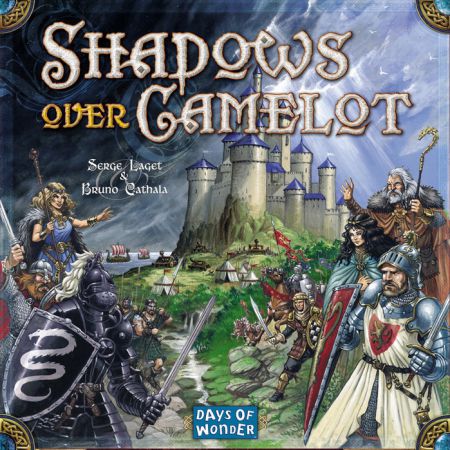
It couldn’t be that simple. Life never is.
One of the players may be a traitor. That’s right. One of you may be secretly rubbing their hands and having a screaming internal evil laughter every time another player gets hit or when a group fails a task and the game gains a win.
The thing is, other players are all on the lookout for the traitor because their actions may cost them their lives, their beloved Camelot and their victory. That is why they can poke and accuse to find out if a traitor is among them but more on this later.
The game was published by the Days of Wonder back in 2005 and it really proved to be an unquestionable classic among board game lovers. Furthermore, it won numerous awards through the years.
You can play with a group of 3 to 7 players and the game can last anywhere from 60 to 90 minutes. I like the duration of it. Considering the rather simple game mechanics and the fact that it is not lengthy, the game will let you play it time and time again without the fear of being bored by the long session or having to learn hundreds of complex rules. This is especially good for the first time players.
How to Play Shadows Over Camelot
Now let’s jump into the nitty gritty of the game. I can tell that you are thirsty for some action! You want to clash some swords with the Black Knight or get those Picts! Enough of this round table talk!
Round table? You are not sure what that is?
The round table in the Camelot is where the game begins. It is where King Arthur slammed his fist on the table and said “let’s kick some serious ass and save this goddamned city”. Or something along those lines.
Characters and their loyalty

Each of the players is randomly assigned a character of a knight of the round table and a loyalty card. Everyone will know which of the knights you are but everyone will keep their loyalty card hidden from the eyes of other knights.
Depending on what loyalty card you are dealt your destiny will forever be set in stone. Or until the next game at least. The loyalty card can either determine you to be loyal to Camelot and the cause or to be a vile traitor who can’t wait to see their fellow knights fall to their demise.
Basic game rules
In a nutshell, Shadows over Camelot functions as a game where the players fulfill the quests either solo or as a group depending on the quest. Each player during their turn has two phases, one is the progression of evil and another is doing a heroic action. Both of these influence quest success and failures.
Your goal as a player is to make sure that you win as many quests as possible in order to earn the white swords and to try and avoid losing quests because they will bring the black swords.
What are these swords you are talking about?
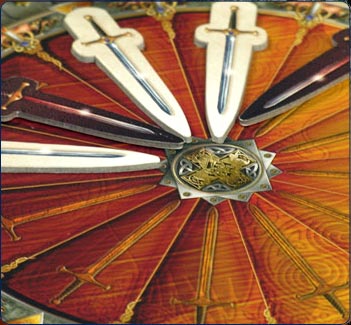
Upon each successful quest completion, you will earn white swords that are added to the round table in the Camelot section of the board game. Each failure of the quest will add black swords to the same table. Once a total of twelve swords are placed on the table the game ends. If at that point there is more white swords the Camelot is saved and you win. If there are more black swords the Camelot is doomed and you all suffer a horrible fate.
The game ends prematurely if the Knights can’t stop any of the following evils to take place:
- 7 or more black swords become present on the round table
- All knights lose their life points and die
- The Camelot gets surrounded by the siege engines
Now, these are just the basics explained. Below I will explain further.
How to Set up and Start the Game

This one is rather simple.
Just place the Master gameboard of Camelot in the center, the quests for the Excalibur, Holy Grail and Lancelot and the Dragon, beside the master gameboard. The main gameboard along with these three quests completes the game board setup. The quest for Lancelot and the Dragon needs to be placed with the Lancelot’s side facing upward.
Prepare the miniatures for the 12 siege engines, 4 Picts, 4 Saxons and the 16 swords and place them somewhere near the main board.
Now to prepare the players for the start.
You need to randomly deal the character role to each player by dealing them a big card with a Knight. Each player needs to read from their Knight card and introduce themselves and their special power (each knight has a different one). Then players place their knight card next to themselves. Then all players place their six sided die on the spot on the knights card with a number four facing upwards. This is their starting life points.
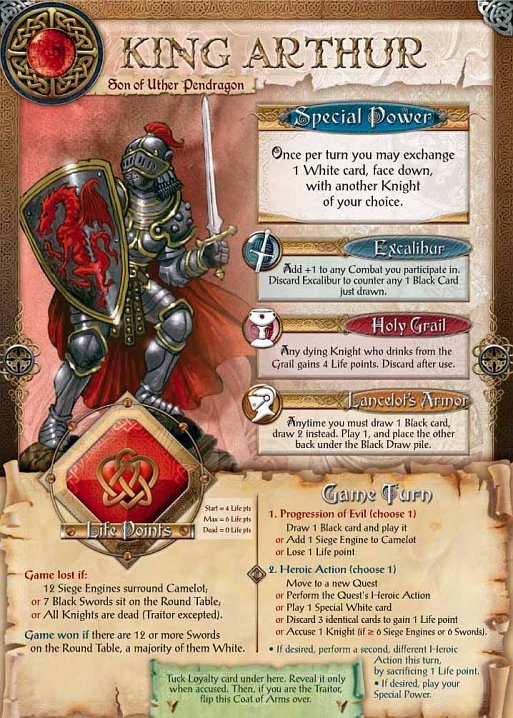
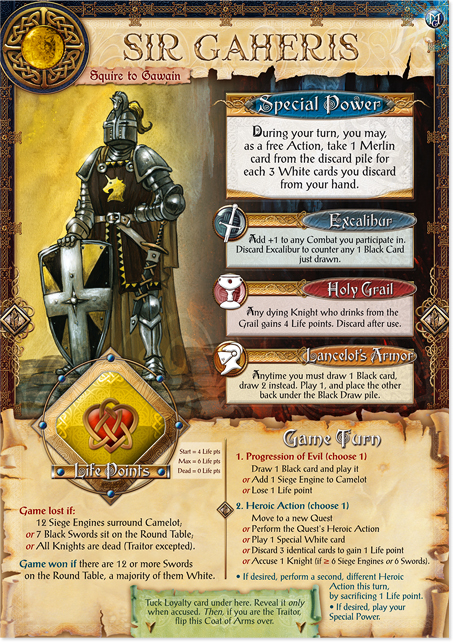
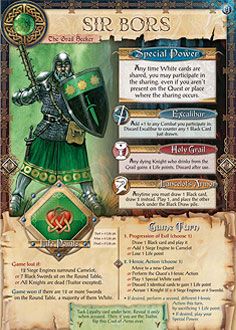
Players then place their Knight’s miniature on its special seat at the Round table. (Each knight is like a VIP there, the seats are marked don’t worry)
You then need to shuffle the loyalty cards and randomly give one per player. Every player needs to check their loyalty without revealing it to anyone. Without saying a word they should place it underneath their Knight’s card. This is the moment the players realize their fate in the upcoming battle. The player will either be in it to win it or to sabotage everyone else and burn down the Camelot!
The next and final step is to give each player one Merlin card, shuffle the rest of the white cards and deal 5 white cards to each player.
Now we are ready to jump into action! Phew, finally!
The Two Phases – Progression of Evil and Heroic Action
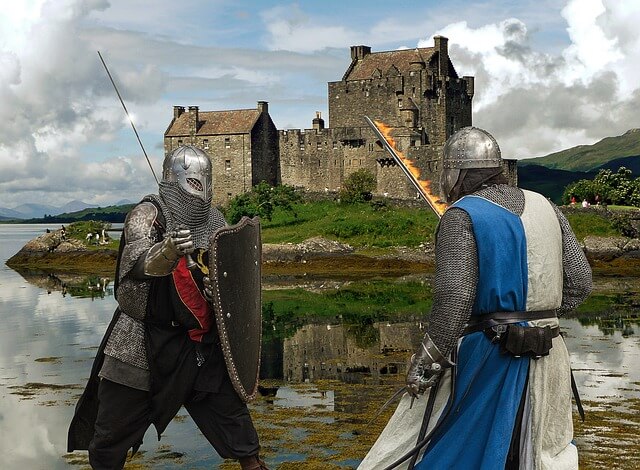
Every player gets to tip the scales during their every turn. During each turn a player will do both, an evil action and a heroic one.
Players take turns clockwise and they do it one after another until either the Camelot is lost as a consequence of their actions or until the 12 swords are present on the round table.
So you are saying that the knights of the round table are bringing evil while fighting it?
If only life was ever so simple. You can’t just pull out your sword and charge without experiencing some consequences! As noted before the evil never sleeps! Night comes before the dawn and so is the case with the Shadows over Camelot. First make your dues with the fate and then fight to save it all!
Progression of Evil
During the first part of the game turn every player can choose one of these evil actions:
- Lose one life point of their character.
- Add one siege engine around Camelot.
- Draw a black card and activate its effect.
Depending on where you are in the game and the current quest you are working on you will have to choose wisely which of these evils is lesser among them. Also, don’t forget to think ahead. Things can get messy down the road if you plant the seed of a wrong evil action at the wrong time.
Heroic Action
Now comes the virtuous part. Time to knight up and handle some of the business!
There are five Heroic actions you can take during the second part of your turn:
- Play a special white card
- Heal your wounds and add a life point to your knight. You must discard 3 identical cards to do so.
- Move to a quest
- Make an action related to your active quest
- Accuse another knight of being a traitor. If 6 or more siege engines are present or 6 swords.
Also, while at Camelot, the player is able to fight a siege engine or draw two white cards in addition to the standard heroic actions.
You should also be careful here. Think before you act. Think about the cards you have, the current quests, try and guess if you could collaborate with other players somehow and always try to think ahead.
The Cards
The Shadows over Camelot functions a lot based on the white and the black cards.
How?
The black cards that can be drawn during the progression of evil game phase are there to bring doom to Camelot.
There are standard black cards and special ones.
Standard ones are placed to their corresponding quests upon being drawn.
Special black cards have a special game affecting power. When you draw them you must read them and apply their effects right away. These special cards can have their effect canceled if you or in a team effort, use 3 Merlin cards. This is very useful in certain situations.
The white cards are obtained at the beginning of the game (5 per each player + a Merlin card). You can also earn them by successfully completing a quest. Every quest rewards you with a various number of white cards.
Same as the black cards, they can be standard or special.
Special white cards are there to influence the game and you can play them as a part of your heroic action if you have them. Merlin is such a card for example.
Standard white cards are used for quest completion.
The Quests of the Game
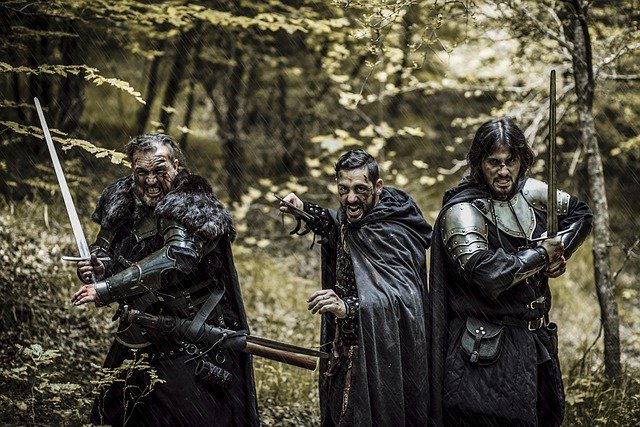
Sometimes you fight and win for good but other times… You can win the battle but not the war.
Quests in the Shadows over Camelot are either perpetual or are completed only once. All of them can either be solo or group quests.
Perpetual quests are:
- Saxon wars
- Picts wars
- The Black Knight Tournament
One time quests:
- Excalibur
- Quest for Lancelot’s Armor
- Holy Grail
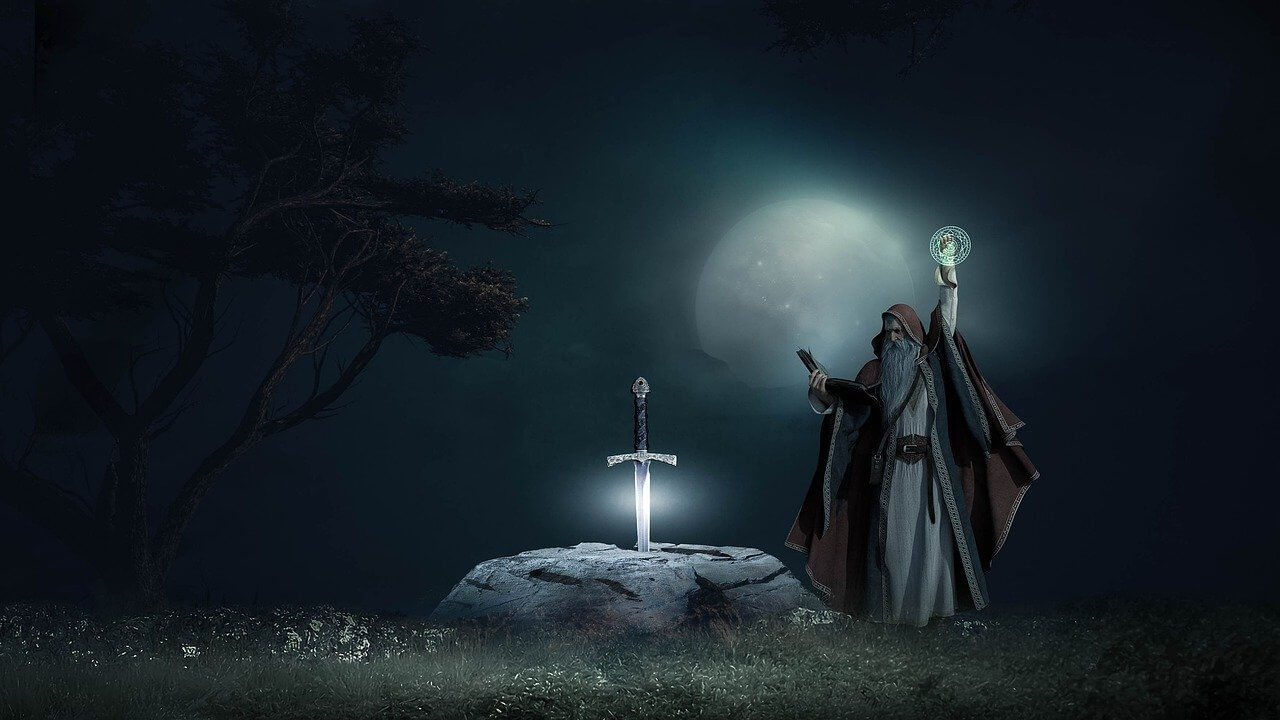
All of the quests are won or lost as a result of the cards played. They are played mostly in different sets but each quest has its own rules except the wars as they are pretty much identical.
Completing quests successfully will bring in big spoils of war to be shared among the group (if done as a group) or to a single player that stroke a winning blow!
The most important rewards are the white swords that are added on the table and the white cards that you get as a reward. You also get a life point for a victory.
Once the one time quests are complete their boards are flipped over with their other side showing what happens next. The Holy grail and Excalibur quests once flipped result in any of their respective cards resulting in addition of a siege engine to Camelot. Once the Lancelot’s Armor is complete and obtained, the quests gets flipped and you get another single time quest. The Dragon quest.
Defeating the dragon will give you a lot of goodies. Two white swords, 7 white cards and you get 2 life points for your character. (Remember you can use these life points for progression of evil and not create a bigger disaster).
The Dan from the Dice Tower made an excellent presentation of each quest in detail. You can check it out here:
The Traitor Among Us
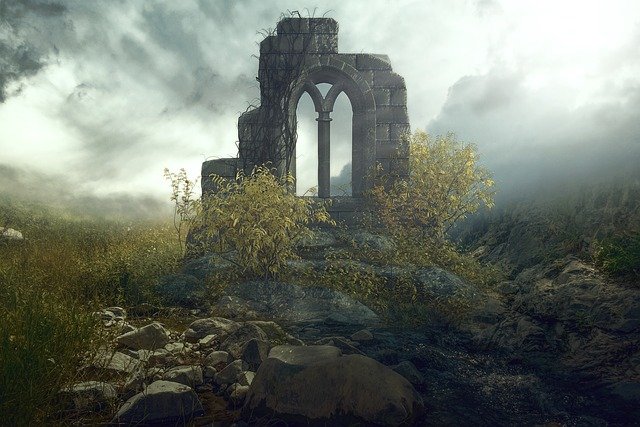
Now back to the beginning. What if you drew the traitor card?
Does all of the above matter to you?
Yes.
Even if you are a traitor you must play by the rules and stay hidden. Never let them know. Bury them in their beloved Camelot underneath of its scorched rocks and shattered dreams!
Claim your victory at the very last moment. The very moment they think they got it all. Just when it is all over you proclaim a shattering laugh and play your traitor card. Defeat them in their own game.
Once the knights assemble the 12 swords at the round table and the game ends it is time to count the number of white and black swords. If the majority is black the Camelot is doomed and vice versa.
If you remain hidden as a traitor all the way to the end you can reveal yourself and at that moment when there is no turning back switch 2 of the white swords to the black. Usually, this means the total demise of Camelot and it’s so called knights of the Round table. March in with the Saxons and the Picts and all the others. Break their castle doors and walls with the siege engines. Watch them as they flee in terror at the sight of you.
But let’s not get ahead of ourselves here. It’s not that simple.
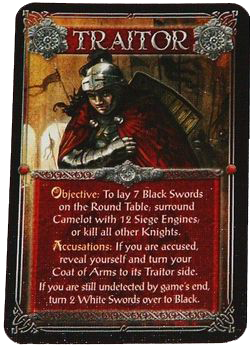
Your job as a traitor is not just to wait until the end to break the big news. You must actively sabotage the “noble” knights. Always be one step ahead of them and make sure that they fail anything they try.
How?
Well, you have to be smart first. Don’t be obvious because they will point a finger at you. Try to get rid of the white cards, lay face down strong black cards where possible and add siege engines. You can also lure them to play certain quests by having them think that you have the cards. Make them waste their heroic action moves. Also, you can falsely accuse someone else of being a traitor just to cause trouble and to turn a white sword to black further helping your cause.
What happens if they see through you? Will you be thrown in the dungeons?
Fortunately for you, no. You get to keep your treachery but now out in the open! You get to mess with their heads and their cards.
Now during your turn, you get to do one of the two things:
- Taunt the knights by picking 1 white card at random from the hand of a knight of your choice and discarding it.
- Help evil spread by either adding one siege engine to Camelot or Drawing and playing a black card.
Shadows Over Camelot Review

Well now once you know exactly how the game works I pronounce you a legitimate knight of the Round table. You may receive your honorable weapon, get a seat at the table and act all important because you are. Just don’t knock something over. Relics on the table are worth more than you can imagine.
Now as a knight you should know my personal thoughts on the game.
This was one of the first cooperative board games with the traitor mechanic and it was great when it first launched. I think it is safe to say that everyone loved it. I still love it and think that it aged like wine. It became a classic board game that is perfect for people who are new to the board games or to people that just want something that is well thought out and laid out.
The plot is very simple but engaging. Even new players will not feel confused by who is who and what is what. It is very simple. Save Camelot or watch it burn (if you are a traitor). Those are your objectives. But even the gameplay is very simple and straightforward which brings me to my next point.
The Shadows Over Camelot will have you really engaged in the play even if it is not your turn. You as a big time knight on a mission to save a city can’t slack off and especially when something starts feeling off. It is almost as if someone is working against you among your people and if you don’t figure out who it may be too late.
That is why you must stay on point. Pay attention to other players. See if you can cooperate with them somehow and see if you can figure out who is working so tirelessly to bring down the Camelot.
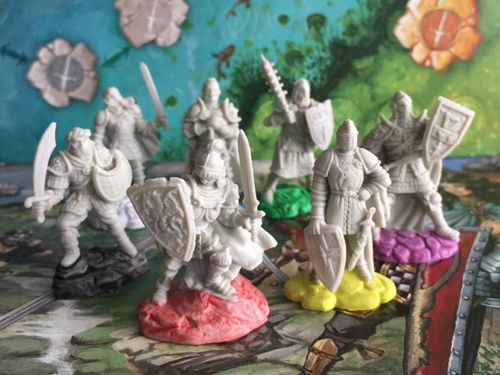
In order to do that you will need to pay attention to everything and to follow other knights a few moves backwards. Why did he go to that quest and then gave up? Why did she add a siege engine? How come that they placed a black card face down for the Black knight?
The boards themselves are so well designed and intuitive that you don’t even need to check the game rule book during the play.
The artwork is beautiful and of really high quality even by today’s standards after way more than a decade since it launched. Cards are so rich with detail and so are the boards. I am someone who loves just to stare into these artworks sometimes and this is one of those board games that I can just look at to figure out the tiny graphical details.
The miniatures are also very beautiful. They are not painted but are made with a lot of attention to detail. You can paint them yourself if you are into that and enhance the experience. Regardless of the paint, they are so detailed that I can just watch them for hours and enjoy their looks.
Conclusion
This is a beautiful, entertaining and well known board game. In my humble opinion, you can’t go wrong with it. But it is up to you to decide if it is something you would like to play based on the information provided above.
I love suggesting it to new people in the games world and in the vast majority of times they love it.
This game has been on my table hundreds of times (I lost count really) and I and my friends barely gotten tired of it. Even after adopting many other newer games as the regulars, this one still has a dear place in everyone’s heart and it is still being played today by me and friends and thousands of players worldwide.
